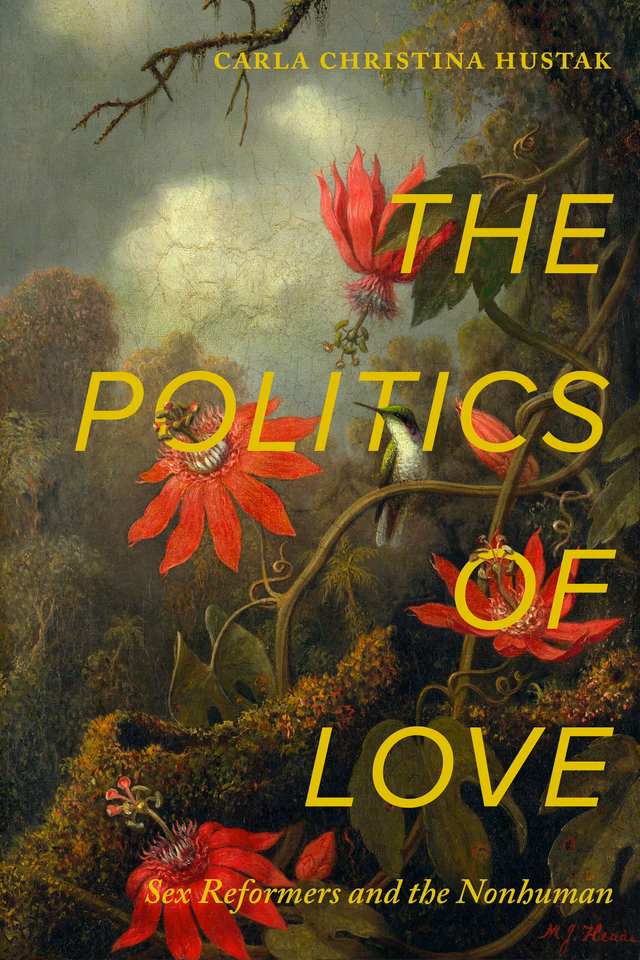
Carla Christina Hustak
The Politics of Love: Sex Reformers and the Nonhuman
University of California Press, 2024.
238 pages
$29.95
Reviewed by Halley Roberts
At the end of the nineteenth century, a turn towards sex reform was a major social catalyst that allowed for the development of birth control clinics, sexual freedom movements, and a relationship with nonhuman actors that redefined how human sexuality was understood. By the early twentieth century, love was the partition that separated heteronormative white middle- and upper-class participants from their nonhuman counterparts. Love was the scientifically-appointed byproduct of evolution that allowed sex reformers to advocate for their movement while keeping some groups from accessing the liberties reformers sought. Carla Christina Hustak’s The Politics of Love frames this reform movement as one that rapidly blurred the lines between human and nonhuman actants, despite the movement’s political motivation to qualify love as intrinsic to human experience. The relationships that defined us were also (re)making us. What Hustak considers the ontological and affective relationship between humans and nonhumans is the defining characteristic that precipitated a robust sex reform movement—and is also the precedent by which many othering narratives regarding class, race, and heteronormative sexual practices would be defined. All this, it seems, relies on the nebulous impact of nonhuman actants on the human experience. Love is the division as well as the unification.
Centralizing much of her historical enquiry between 1890 and 1930, The Politics of Love outlines the transnational sex reform movement instigated by Charles Darwin’s evolutionary theory through an interdisciplinary engagement with love and all its affective and ontological qualities. As she explores what it means to consider love as a social and biological phenomenon intrinsic to our own sense of being, Hustak breaks down the blurred lines of kinship that unify rather than separate the human from the animal. In Chapter One, Hustak begins by charting Darwinian advances in evolutionary studies within the context of the growing psychology field and their subsequent impact on sex reform. In particular, Hustak outlines humankind’s growing relationship with animal sexuality: an increase in animal experimentation was the impetus for new ways of restricting love to sexual relationships between human beings. Though biologists and sex reformers relied on animals in order to understand their own carnal biology, the labor of this progress merely reinforced a dichotomy between acceptable and unacceptable sexual experience. Hustak foregrounds that these reform movements catalyzed major experiments in eugenics. In Chapter Two, Hustak transitions to plant life, further accentuating the lack of distance between human and nonhuman experiences with love, despite sex reformers’ motivations to establish that distance. In Chapter Three, Hustak addresses the role of physics and spirituality within the sex reform movement. It makes sense, Hustak argues, for conversations regarding spiritual purpose to infiltrate the movement’s values, since those conversations naturalize the progression of human thought towards a higher spiritual order that also resonates with the contemporary feminist pivot to affective relationality. Chapter Four covers a more in-depth account of love’s political-affective qualities. Noting that the domain of love was settled by “civilized” actors sketching the relational boundaries that excluded anyone or anything “primitive,” Hustak draws out the politics of the sex reform movement and that politic’s relationship to biology, psychology, and spirituality. Technological and discursive developments—new forms of love enabled by sex manuals and objects—produced public concern about what constituted natural or unnatural sexuality. Chapter Five ties a bow around Darwinian social influence, turning to the effects of these political and affective changes in urban areas. Intellectual Darwinism entered the city and brought with it an explosion of intersecting discourses: xenophobia, nativism, and feminism are all ideologies stimulated and shaped by the impact of evolution on women’s bodies.
In Hustak’s own words: “this is not a narrative that aims to show progress but, instead, to highlight a radical revision to not only our concept of love but also to our concepts of time and kinship,” later adding that “love itself cannot be said to have a definite beginning or end. I would argue that love’s temporalities are genealogical, connective, fluctuating, and recurring, rather than linear.” As she traces early psychological and biological developments, much of the nineteenth-century scientific history feels relevant to our current rhetoric about sexual experience, love, and human agency. These connections are worth mentioning not just because Hustak asks her reader to consider the scholarly responsibility to return to history with new theoretical frameworks, but also because the racialization processes produced by this history are ongoing. Who we are is described by what we are not. The underlying concern of both nineteenth-century scientific and political reform and contemporary reform is mostly unchanged: how do we separate the right kind of love from the baseness of nonhuman sexual encounters? How might the bedrock of our social identity be defined by the answer? How do we reconcile a past and present that relies on experimenting with/on the nonhuman so that we make the human rely on an understanding of the nonhuman in order to be human?
Early biologists, psychologists, and sex reformers believed that ‘love’ separated them from their animal and plant kin, which allowed them to experiment and examine nonhuman participants in an effort to understand sexuality. Therefore, reliance on these nonhuman material actants defines our very notion of what it means to love and what it means to be human. Love, according to Hustak, was always an affective factor by which we might tether ourselves to (and separate ourselves from) the nonhuman beings that define us. The Politics of Love is a satisfying assessment of a key global movement, as well as an invitation to consider the implications of that movement. As Hustak addresses in her conclusion, “to explore the genealogy of contemporary advances in reproductive science necessarily entails grappling with the Darwinian past of genetics and the nonhuman actors in love’s evolutions.” In other words, what we know now is what we built then. How we arrived, how far we’ve come, and how far we have yet to go, is not such a great distance after all.

